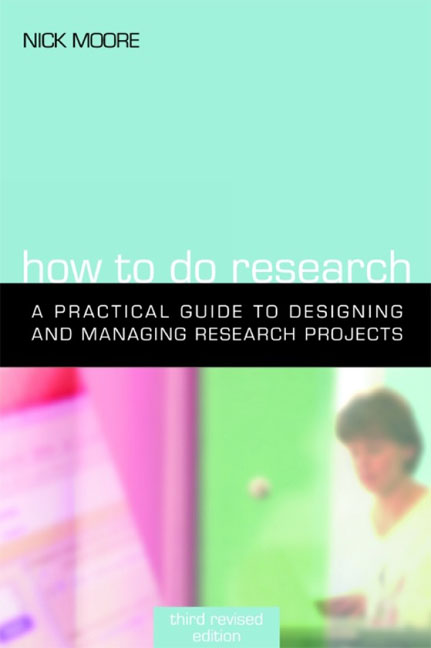Book contents
- Frontmatter
- Contents
- Acknowledgements
- Introduction: Types of research
- Part 1 The research process
- Part 2 Methods
- 9 Introducing research methods
- 10 Desk research
- 11 Analysing desk research
- 12 Collecting quantitative data
- 13 Analysing quantitative data
- 14 Collecting qualitative data
- 15 Analysing qualitative data
- 16 Sources of further reading
- Appendix The market for information professionals: A proposal from the Policy Studies Institute
- Index
9 - Introducing research methods
from Part 2 - Methods
Published online by Cambridge University Press: 09 June 2018
- Frontmatter
- Contents
- Acknowledgements
- Introduction: Types of research
- Part 1 The research process
- Part 2 Methods
- 9 Introducing research methods
- 10 Desk research
- 11 Analysing desk research
- 12 Collecting quantitative data
- 13 Analysing quantitative data
- 14 Collecting qualitative data
- 15 Analysing qualitative data
- 16 Sources of further reading
- Appendix The market for information professionals: A proposal from the Policy Studies Institute
- Index
Summary
Methods are the tools of the researcher's trade. You need to know how to use them but, just as important, is knowing when they should be used. The perfect researcher will be familiar with the widest possible range of methods and will deploy them selectively to meet the requirements of different circumstances.
For the rest of us, our aspirations are more modest. Most of us can only hope to be familiar with a limited range of methods, understanding their strengths and weaknesses and being aware of when to use one in preference to another. With luck, we will also know that there are lots of other different ways of approaching the collection and analysis of data and we will be in a position to identify when we need to extend our personal range of skills by learning to use a new method.
This part of the book aims to give you an overview of the range of social research methods that are available to you. It will indicate the strengths and weaknesses of each method and will suggest when and under which circumstances, they should be used. It will also give you some hints and tips that will help you get going. What it will not do is provide a detailed treatise on social research methods in all their sophisticated glory. There are plenty of other books that do this. Some of them have even been written by people who have actually used the methods. A selection of them is listed in the guide to further reading in Chapter 16.
At this point it is worth saying a word about triangulation. Many researchers use only one method at a time to collect data – the research project will consist of a questionnaire survey, or a series of focus groups. There is, however, much to be gained by using more than one method to explore an issue from different perspectives. A relatively large scale questionnaire survey will, for example, provide a broad picture. This picture can be enriched by a series of focus groups to explore aspects of the topic in more depth. The whole thing can be put into a wider context by a thorough review of the literature and consideration of the results of previous research on the topic. The jargon term for looking at things in this way is triangulation.
- Type
- Chapter
- Information
- How to Do ResearchA practical guide to designing and managing research projects, pp. 103 - 105Publisher: FacetPrint publication year: 2006



